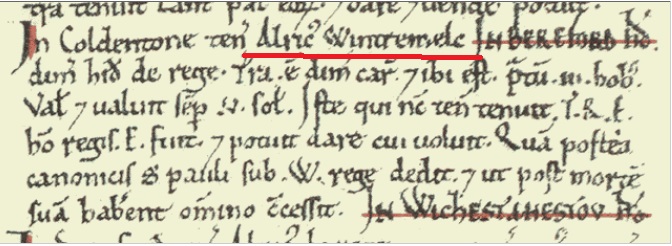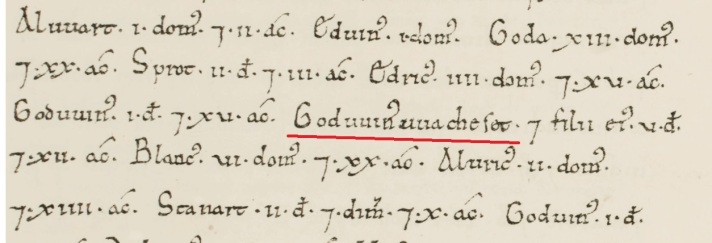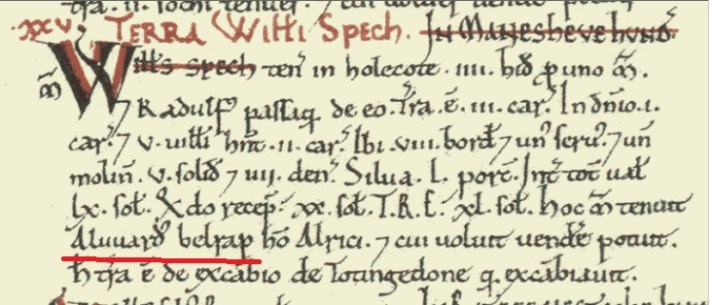From Humphrey ‘Golden-bollocks’ to Alwy ‘Beetle-beard’ – this blog post deals with the remarkable bynames found for individuals mentioned in the Domesday Book.
Domesday Book as a cultural treasure trove
The Domesday Book is perhaps the most famous administrative record from the Middle Ages. The Domesday Book was made in 1086 by order of William the Conqueror in 1086, who wanted to know whom he could tax and how much. The result is a long and detailed work, listing the various duties and payments that had to be made to the crown as well as the names and holding of landowners living in 1086. The Domesday Book also includes an overview of the situation during the reign of William’s predecessor Edward the Confessor in 1066. William’s scribes were thorough, indeed, as the Peterborough Chronicle remarks:

Swa swyðe nearwelice he hit lett utaspyrian. þæt næs an ælpig hide. ne an gyrde landes. ne furðon, hit is sceame to tellanne. ac hit ne þuhte him nan sceame to donne. an oxe. ne an cu. ne an swin. næs belyfon. þæt næs gesæt on his gewrite.
[So very narrowly did he command them to record it, that there was not one single hide, not one yard of land, moreover (it is a shame to say it, but it did not seem to him a shame to do it) not one ox, not one cow, not one swine was left, that was not set down in his book.]
While the Domesday Book is mostly used as a source for the social and economic history of eleventh-century England, it is also a treasure trove for those interested in more cultural phenomena, such as bynames and nicknames.
Anglo-Norman and Latin bynames from the Domesday Book
A byname is an additional name to a person’s main name, which often allows for a clearer identification of the individual. Often, such bynames take a locational form, allowing us to distinguish between such a Wulfstan of York and a Wulfstan of Worchester. More interesting are those bynames that describe physical, mental or moral characteristics. The last category is known as nicknames and can often be jocular. Some intriguing Anglo-Norman and Latin nicknames found in the Domesday Book are listed below:
Bernardus panceuolt – Bernard ‘Paunch-face’
Hunfridus uis de leuu – Humphrey ‘Face of a wolf’
Hunfridus aurei testiculi – Humphrey ‘Golden-bollocks’
Rogerus Deus saluaet dominas – Roger ‘God save the ladies’
Slideshow with Anglo-Norman and Latin nicknames. Source images: opendomesday.org
Top 10 Old English nicknames from the Domesday Book
Fascinating though the Anglo-Norman and Latin nicknames are, I was mainly interested to find some Old English nicknames and have listed my personal top 10 (in no particular order) below:
10) Aluui Ceuresbert – Alwy ‘Beetle-beard’

Alwy was a landowner in Thatcham, Berkshire, with, as it would seem, a remarkable beard. His nickname ‘ceuresbert’ is a compound of Old English ceafor ‘chafer, beetle’ and beard ‘beard’, suggesting that he may have had a two-pronged beard resembling the antennae of a beetle.
9) Alwinus Bollochessege – Alwine ‘Bullock’s eye’
Alwinus Bollochessege lived in Winchester in 1066. Since Winchester was not included in the survey for the original Domesday Book, his name is found in what is known as the Liber Winton or Winchester Domesday Book: a twelfth-century document, based on an earlier, now-lost document. The nickname of Alwine is made up of the Old English words bulluc ‘bullock’ and eage ‘eye’ (see Tengvik 1938, 295).
8) Ernuin Catenase – Ernwine ‘Cat’s nose’
Ernuin Catenase (catt ‘cat’ + nasu ‘nose’) was a landowner in Yorkshire, owning lands and manor in Scacherthorpe and Upper and Lower Poppleton. The Domesday Book records that his lands were granted to an Ernwine with a less unfortunate byname: Ernwine the priest.
7) Alricus Wintremelc – Alric ‘Winter-milk’

Alricus Wintremelc was the tenant-in-chief of Goldington, Bedfordshire. His pretty straightforward nickname is, nevertheless, more intriguing than that of Ailmar Melc who lived in Tolleshunt, Essex.
6) Goduuinus Wachefet – Godwine ‘Weak-feet’

Godwine ‘Weak-feet’ was one of the tenants of Gloucester in 1066. In this list we can clearly see that Godwine’s nickname was added to separate him from another “Goduuinus” and a “Goduinus”.
5) Goduuinus Softebread – Godwine ‘Soft-bread’
Another inhabitant of Winchester, mentioned in the Liber Winton (see Tengvik 1938, 380).
4) Godwinus Penifeder – Godwine ‘Penny-father’
Godwin Penny-father lived in Winchester and his nickname suggests that he was something of an Anglo-Saxon Scrooge. He apparently lived in the same street as Aluricus Penipurs – Alfric ‘Penny-purse’ (see Tengvik 1938, 353).
3) Aluuardus Belrap – Alward ‘Bell-rope’

In 1066, Alward ‘Bell-rope’ was the lord of Holcot, Bedfordshire. Interestingly, his lordship had passed over in 1086 to one “Radulfus Passaqua”: Ralph ‘Pass-water’.
2) Aluuinus Deule – Alwine ‘The devil’

Alwine ‘the devil’ was a Bedfordshire landowner not to be meddled with!
1) Aluredus Caddebelloc – Alfred ‘Testicle-testicle’
Another landowner in Winchester in 1066 – name mentioned in Liber Winton. According to Tengvik (1938) this is a tautological compound of OE/ME cade ‘testicle’ and balluc ‘testicle’: Alfred ‘Testicle-testicle’, lest we confuse him with Alfred ‘the Great’…
If you liked this blogpost, you may also be interested in the following post:
- Arseling: A Word Coined by Alfred the Great? (on the nickname ‘Arseling’, popularised by BBC’s The Last Kingdom)
- How Cnut became Canute (on the name of Viking king Cnut the Great)
- Naming names in Ælfwine’s Prayerbook (a great blogpost by For the Wynn)
Works referred to:
- G. Tengvik, Old English Bynames (Uppsala, 1938)

Another fascinating post. It’s so tempting to speculate about the people behind the names.
LikeLiked by 1 person
Reblogged this on jeevesdownunder and commented:
Interesting part of history and makes me wonder how we see and name people today.
LikeLiked by 1 person
Huge amount of good detail
LikeLike
A person was once called “ass-butt” in my hearing, from which I infer that the person who named Caddebelloc has literary heirs surviving to the modern day. How many of his or her contemporaries can say the same?
LikeLike